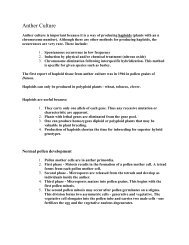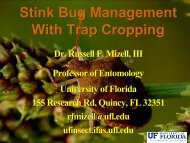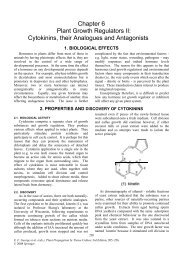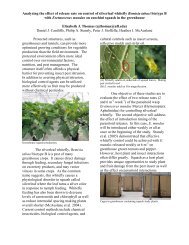The Components of Plant Tissue Culture Media II - Horticultural ...
The Components of Plant Tissue Culture Media II - Horticultural ...
The Components of Plant Tissue Culture Media II - Horticultural ...
Create successful ePaper yourself
Turn your PDF publications into a flip-book with our unique Google optimized e-Paper software.
144 <strong>The</strong> <strong>Components</strong> <strong>of</strong> <strong>Plant</strong> <strong>Tissue</strong> <strong>Culture</strong> <strong>Media</strong> <strong>II</strong><br />
acid was an effective buffer and appeared to enhance<br />
the effect <strong>of</strong> the glutamine and alanine which they<br />
added to their medium. Vyskot and Bezdek (1984)<br />
found that the buffering capacity <strong>of</strong> MS medium was<br />
increased by adding either 1.25 mM sodium citrate or<br />
1.97 mM citric acid plus 6.07 mM dibasic sodium<br />
phosphate. Citric acid and some other organic acids<br />
have been noted to enhance the growth <strong>of</strong> Citrus<br />
callus when added to the medium (presumably that <strong>of</strong><br />
Murashige and Tucker, 1969) (Erner and Reuveni,<br />
1981). For the propagation <strong>of</strong> various cacti from<br />
axillary buds, Vyskot and Jara (1984) added sodium<br />
citrate to MS medium to increase its buffering<br />
capacity.<br />
Recognized biological buffers: Unlike organic<br />
acids, conventional buffers are not metabolised by the<br />
plant, but can poise pH levels very effectively.<br />
Compounds which have been used in plant culture<br />
media for critical purposes such as protoplast<br />
isolation and culture, and culture <strong>of</strong> cells at very low<br />
inoculation densities, include:<br />
• TRIS, Tris(hydroxymethyl)aminomethane;<br />
• Tricine, N-tris(hydroxymethyl)methylglycine;<br />
• MES, 2-(N-morpholino)ethanesulphonic acid;<br />
• HEPES, 4-(2-hydroxyethyl)-1-piperazine(2ethanesulphonic<br />
acid); and<br />
• CAPS, 3-cyclohexylamino-1-propanesulphonic<br />
acid.<br />
Such compounds may have biological effects<br />
which are unrelated to their buffering capacity.<br />
Depending on the plant species, they have been<br />
known to kill protoplasts or greatly increase the rate<br />
<strong>of</strong> cell division and/or plant regeneration (Conrad<br />
et al., 1981). <strong>The</strong> ‘biological’ buffers MES and<br />
HEPES have been developed for biological research<br />
(Good et al., 1966).<br />
MES: MES is one <strong>of</strong> the few highly effective and<br />
commercially available buffers with significant<br />
buffering capacity in the pH range 5-6 to which plant<br />
culture media are usually adjusted and has only a low<br />
capacity to complex with micronutrients. It is not<br />
toxic to most plants, although there are some which<br />
are sensitive. Ramage and Williams (2002) report<br />
that shoot regeneration from tobacco leaf discs was<br />
not affected by MES when increasing the<br />
concentration up to 100 mM. De Klerk et al (2007),<br />
though, observed a decrease <strong>of</strong> rooting from apple<br />
stem slices with increasing MES concentration (see<br />
below; Fig. 4.4). This effect <strong>of</strong> MES was not<br />
understood. It only occurred during the first days <strong>of</strong><br />
the rooting process and was not observed during the<br />
outgrowth phase after the meristems had been<br />
formed.<br />
During the culture <strong>of</strong> thin cell layers <strong>of</strong> Nicotiana,<br />
Tiburcio et al. (1989) found that the pH <strong>of</strong> LS<br />
medium could be kept close to 5.8 for 28 days by<br />
adding 50 mM MES, whereas without the buffer pH<br />
gradually decreased to 5.25. Regulating pH with<br />
MES alters the type <strong>of</strong> morphogenesis which occur in<br />
this (and other) tissues (see below).<br />
Parfitt et al. (1988) found 10 mM MES to be an<br />
effective buffer in four different media used for<br />
tobacco, carrot and tomato callus cultures, and peach<br />
and carnation shoot cultures, although stabilizing pH<br />
did not result in superior growth. <strong>The</strong> tobacco, peach<br />
and carnation cultures were damaged by 50 mM<br />
MES. Tris was toxic at all concentrations tested,<br />
although Klein and Manos (1960) had found that the<br />
addition <strong>of</strong> only 0.5 mM Tris effectively increased<br />
the fresh weight <strong>of</strong> callus which could be grown on<br />
White (1954) medium when iron was chelated with<br />
EDTA.<br />
MES has also been used successfully to buffer<br />
many cultures initiated from single protoplasts<br />
(Müller et al., 1983) and its inclusion in the culture<br />
medium can be essential for the survival <strong>of</strong> individual<br />
cells and their division to form callus colonies (e.g.<br />
those <strong>of</strong> Datura innoxia - Koop et al., 1983). MES<br />
was found to be somewhat toxic to single protoplasts<br />
<strong>of</strong> Brassica napus, but ‘Polybuffer 74’ (PB-74, a<br />
mixture <strong>of</strong> polyaminosulphonates), allowed excellent<br />
microcolony growth in the pH range 5.5-7.0<br />
(Spangenberg et al., 1986). Used at 1/100 <strong>of</strong> the<br />
commercially available solution, it has a buffering<br />
capacity <strong>of</strong> a 1.3 mM buffer at its pK value (Koop<br />
et al., 1983).<br />
Banana homogenate is widely used in orchid<br />
micropropagation media. Ernst (1974) noted that it<br />
appeared to buffer the medium in which slipper<br />
orchid seedlings were being grown.<br />
5.1.2. <strong>The</strong> uptake <strong>of</strong> ions and molecules<br />
<strong>The</strong> pH <strong>of</strong> the medium has an effect on the<br />
availability <strong>of</strong> many minerals (Scholten and Pierik,<br />
1998). In general, the uptake <strong>of</strong> negatively charged<br />
ions (anions) is favoured at acid pH, while that <strong>of</strong><br />
cations (positively charged) is best when the pH is<br />
increased. As mentioned before, the relative uptake <strong>of</strong><br />
nutrient cations and anions will alter the pH <strong>of</strong> the<br />
medium. <strong>The</strong> release <strong>of</strong> hydroxyl ions from the plant<br />
in exchange for nitrate ions results in media<br />
becoming more alkaline; when ammonium ions are






